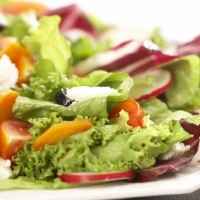How Do Raw Food Enzymes Work?
When you were younger, your parents might have given you the option of having your veggies cooked or not with dinner. Cooked usually meant a quick dip in a pot of boiling water, and while your parents were probably just happy to see you eating something healthy, they might have cryptically told you that eating those carrots, peas and cauliflower raw would be better for you.
Get Best Healthy Weight Loss Diet Plan ProgramBut if you pressed the point, they might have been at a loss to tell you why. These days, we know a lot more about the raw food enzymes that are lost in the cooking process so, when your kids ask why it's better to eat raw, you'll be able to tell them exactly what the benefits are.
To break it down to its simplest definition, an enzyme is a protein that increases the rate of a chemical reaction. Enzymes are not destroyed when they assist these reactions. They are an important part of our healthy living; in fact, one of the most effective poisons against humans, cyanide, is at its heart a simple enzyme inhibitor, combining with copper and iron in the body to retard cellular respiration.
Enzymes were first discovered in the 1930s when scientists worked to make bread more stable as a product. They found that removing the diastase enzymes from the wheat germ helped produce a longer-lasting product, the resulting bread contained no natural enzymes to break down and consume the ingredients while out on the counter, but the same thing held true once the bread was eaten. The longer the shelf life, the harder it became to digest. Some studies have theorized that gluten intolerance might the result of removing these enzymes from many bread products.
Get Best Healthy Weight Loss Diet Plan ProgramRaw foods have enzymes of their own. As such, when they are consumed in their raw state, these enzymes are used to help break down the food into fuel for the body, assist in the absorption of nutrients and vitamins, and aid in the whole process of digestion and elimination.
These food enzymes, however, are fairly vulnerable. Much like our bodies, exposure to extreme heat can kill them. After exposure to 118 degrees Fahrenheit, most food enzymes are rendered useless, and anything consumed will have to use the body's own stores of enzymes for digestion and absorption. This means that your body and the organs used to process food, like the pancreas, work harder when you eat cooked foods, which can lead to problems later on in life. The pancreas is where your body produces enzymes to help digest foods. A diet low in incoming enzymes could cause an overworked pancreas to swell and enlarge, and lead to problems as mild as gas and bloating, to more serious conditions like diabetes.
There are a few main types of enzymes that you use from raw foods: Cellulose enzymes help to deconstruct cellulose molecules; lipase enzymes work on fats; and protease enzymes are for proteins. These enzymes work to make your food into something the body can absorb quickly and easily.
Get Best Healthy Weight Loss Diet Plan Program-
The South Beach Diet Fat Loss Program
In the left, Fat Loss 4 Idiots, and on the right, South Beach Diet. On
-
Herbal Diet Pills Supplements that will Help you in your Weight Loss Program
With herbal diet pills help you in your weight loss program options a
-
Ketosis Diet for Weight Loss
Im sure there are some of you who have already heard for the name keto
-
Quick solution to obesity comes with Tacoma HCG
When you have tried all those highly endorsed weight loss plans and ha
-
Fit or Fat?!
"Hey, you have reduced now, compared to the las
-
Learn Which Body Fat Loss Programs Are Actually Worth Your Time & Effort And Find Out How Quickly You Can Lose The Weight! - Ever Loss
CLICK HERE NOW to Download The EverLoss System and Start Losing 23 LBS
- DON'T MISS
- Over 40 weight loss for women - Explore relevant facts about what to do or not!
- Begin To Eat Healthier, Get Lighter - Part 1
- How to Use Portion Control As a Part of a Weight Loss Program
- How To Get 6 Pack Abs In 1 Week
- Extra fat Products ( blank ) Which usually Fat Formula Is fine Right for you?
- Bowtrol - The Colon Cleaning Wonder Medicine
- Exercises to Reduce Calf
- 7 Easy Ways For You to Lose Weight
- How to lose weight naturally & reverse diabetes in 90 days without giving Up sweets
- I Am Desperate To Lose Weight! How Can I Lose Fat Just Like The People On The Television Fitness Competitions?




